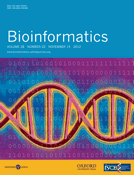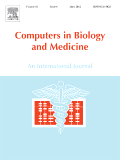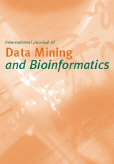
BIOINFORMATICS
metrics 2024
Pioneering Insights in Biochemistry and Computational Science
Introduction
BIOINFORMATICS, published by Oxford University Press, is a leading journal in the realms of biochemistry, computational mathematics, and computer science, with a notable impact factor that underscores its significance in the field. Since its inception in 1985 and continuing through its expected convergence in 2024, the journal has maintained a prestigious reputation, proudly residing in the Q1 category across multiple disciplines, including molecular biology and statistics. With a Scopus ranking placing it within the top percentiles of its categories, BIOINFORMATICS serves as an essential platform for disseminating high-quality research that advances knowledge and innovation at the intersection of biology and computational sciences. This journal not only offers both subscription and open access options, ensuring wider availability of its cutting-edge research, but it has also become a crucial resource for researchers, professionals, and students aiming to stay at the forefront of bioinformatics and related fields. Explore the latest findings and trends that define the future of biological research through this esteemed publication, any inquiries regarding the journal can be directed to its offices located at Great Clarendon St, Oxford OX2 6DP, England.
Metrics 2024
 2.57
2.57 4.40
4.40 7.60
7.60 462
462Metrics History
Rank 2024
Scopus
IF (Web Of Science)
JCI (Web Of Science)
Quartile History
Similar Journals

COMPUTERS IN BIOLOGY AND MEDICINE
Transforming Healthcare Through Cutting-Edge Computer ScienceCOMPUTERS IN BIOLOGY AND MEDICINE is a prestigious academic journal published by Pergamon-Elsevier Science Ltd, dedicated to advancing the fields of Computer Science Applications and Health Informatics. With an impressive impact factor and ranking within the Q1 quartile for both categories, this journal plays a crucial role in disseminating high-quality research findings that influence cutting-edge developments at the intersection of computing and healthcare. Covering a broad range of topics from computational biology to medical informatics, it serves as a vital resource for researchers, professionals, and students striving to harness technology for medical advancements. The journal has been publishing since 1970 and continues to evolve, incorporating the latest trends and innovations in the field, thereby ensuring that it remains a key contributor to scientific inquiry and knowledge. With accessible content and a global reach, COMPUTERS IN BIOLOGY AND MEDICINE invites submissions that elevate the understanding and application of computational methods in biological and medical contexts.

MOLECULAR GENETICS AND GENOMICS
Innovating Insights in Genetics and GenomicsMOLECULAR GENETICS AND GENOMICS is a distinguished journal published by SPRINGER HEIDELBERG that serves as a pivotal platform for the communication of cutting-edge research and developments in the fields of genetics, molecular biology, and medicine. With an ISSN of 1617-4615 and an E-ISSN of 1617-4623, this journal has established itself since its inception in 1994 as a significant resource for researchers aiming to explore the complexities of genetic interactions and their implications in various biological systems. The journal is indexed in Scopus, with respectable rankings in the Genetics, Molecular Biology, and Biochemistry categories, showcasing its position within the academic community. It is categorized in the 2023 rankings as Q3 in Genetics, Q2 in Medicine (miscellaneous), and Q3 in Molecular Biology, indicating its relevance and quality in the scientific discourse. The journal also promotes open access, ensuring that researchers and professionals can easily share and advance knowledge in the rapidly evolving disciplines of molecular genetics and genomics. As the journal continues to bridge the gap between experimental and theoretical research, it presents a vital space for innovation, fostering collaborations and scholarly exchange among its readership.

PROTEINS-STRUCTURE FUNCTION AND BIOINFORMATICS
Illuminating the Pathways of Protein SciencePROTEINS - STRUCTURE FUNCTION AND BIOINFORMATICS, published by WILEY, is a leading journal in the fields of biochemistry, molecular biology, and structural biology, recognized for its significant contribution to protein research since its inception in 1986. With its impressive rankings in the Q1 category for Biochemistry and Q2 for both Molecular Biology and Structural Biology in 2023, the journal serves as an essential resource for researchers and professionals seeking to explore the intricate relationships between protein structures and their functions. The journal, based in the United States, operates without an Open Access model, ensuring a curated selection of high-quality peer-reviewed articles that drive innovation and collaboration in the scientific community. Engaging with the robust content of PROTEINS not only bolsters academic scholarship but also opens avenues for groundbreaking discoveries that are pivotal in the advancing field of bioinformatics.

Molecular Systems Biology
Integrating Quantitative Insights into Biological ComplexityMolecular Systems Biology, published by SpringerNature, is a premier open access journal that has been a cornerstone in advancing the fields of biological science since its inception in 2005. With its ISSN 1744-4292, this journal exemplifies high scholarly standards, boasting an impressive suite of impact factors, including Q1 rankings across various disciplines such as Agricultural and Biological Sciences, Biochemistry, Genetics and Molecular Biology, and more, highlighting its significant contribution to the scientific community. The journal offers robust access options to facilitate innovative research dissemination, reaching a global audience while maintaining a commitment to fostering collaboration and dialogue among researchers, professionals, and students. With a focus on integrating quantitative approaches to biological systems, Molecular Systems Biology plays a vital role in addressing complex biological questions, paving the way for groundbreaking discoveries and advancements in healthcare, environmental sustainability, and functional genomics.

Cell Systems
Pioneering Discoveries in Systems BiologyCell Systems is an esteemed journal published by CELL PRESS, dedicated to advancing the field of systems biology and its applications in cell biology, histology, and pathology. Since its inception in 2015, it has quickly ascended to a prominent position within the academic community, currently holding a Q1 ranking across multiple categories including Cell Biology, Histology, and Pathology and Forensic Medicine for 2023. With an impressive Scopus ranking—third in Medicine: Pathology and Forensic Medicine, and similarly high standing in Histology—it serves as a key resource for researchers and professionals aiming to explore and disseminate cutting-edge research findings. The journal provides an open-access platform, making it an accessible source of knowledge for students and scholars alike, fostering collaboration and innovation within the dynamic landscape of cellular research. With a commitment to high-quality and impactful publications, Cell Systems plays a pivotal role in shaping the future of biological sciences.

COMPUTATIONAL BIOLOGY AND CHEMISTRY
Pioneering Solutions for Tomorrow’s Biological Challenges with Computational TechniquesCOMPUTATIONAL BIOLOGY AND CHEMISTRY is a distinguished academic journal published by Elsevier Science Ltd, focusing on the dynamic intersection of computational biology, biochemistry, and chemistry. With an ISSN of 1476-9271 and an E-ISSN of 1476-928X, this journal is committed to disseminating high-quality research that employs computational techniques to solve complex biological and chemical problems. As of 2023, the journal holds a substantial impact factor reflecting its significance and rigorous peer-review process, categorized in the Q2 quartile for both Computational Mathematics and Organic Chemistry, alongside Q3 classifications in Biochemistry and Structural Biology. With a continuous publication history spanning from 2003 to 2024, it serves as a critical resource for researchers, professionals, and students alike. The journal offers various open access options, ensuring that vital research findings are accessible to a global audience, further enhancing collaboration across disciplines. Engage with cutting-edge studies and contribute to the evolving landscape of computational methodologies in the life sciences through this esteemed publication.

International Journal of Data Mining and Bioinformatics
Exploring Innovations at the Intersection of Data and Biology.The International Journal of Data Mining and Bioinformatics, published by InderScience Enterprises Ltd, stands as a crucial platform for researchers and professionals dedicated to the intersection of data science and biological informatics. With its ISSN 1748-5673 and E-ISSN 1748-5681, this journal captures the essence of innovative research from 2006 to 2024. Though indexed in the Q4 category for Biochemistry, Genetics and Molecular Biology and Information Systems, it maintains a respectable Q3 status in Library and Information Sciences, reflecting its growing influence within the academic community. The journal also provides insightful contributions to the fields of big data analytics, machine learning, and computational biology. Although it is not currently an open-access journal, its relevance is underscored by its Scopus rankings, indicating a solid standing in the disciplines it encompasses. Researchers, students, and practitioners in data mining and bioinformatics are encouraged to explore the findings and methodologies presented, paving the way for future innovations in this dynamic field.

Bioinformatics Advances
Exploring the Intersection of Biology and TechnologyBioinformatics Advances, published by Oxford University Press, is an esteemed academic journal that serves as a vital platform for the dissemination of innovative research in the rapidly evolving fields of bioinformatics and computational biology. With a promising E-ISSN of 2635-0041, this journal has made significant strides since its inception in 2021, achieving a commendable Q1 ranking in both the Computer Science Applications and Genetics categories, alongside respectable Q2 rankings in Molecular Biology and Structural Biology as of 2023. Though currently not an open-access publication, its critical insights cater to an audience keen on advancing knowledge and technology in genomic studies and data analytics. The journal emphasizes high-quality research and aims to facilitate the integration of computational techniques within biological sciences, making it an essential resource for researchers, professionals, and students alike who seek to stay at the forefront of bioinformatics advancements.

Briefings in Functional Genomics
Advancing the Frontiers of Functional GenomicsBriefings in Functional Genomics, published by Oxford University Press, serves as a crucial academic resource in the fields of biochemistry, genetics, and molecular biology. With an ISSN of 2041-2649 and an E-ISSN of 2041-2657, this esteemed journal explores innovative research and developments in functional genomics, with a commitment to advancing our understanding of genetic processes and their implications in health and disease. Ranking in the Q2 quartile for both Biochemistry and Genetics, and occupying a prominent Q1 status in the domain of interdisciplinary Medicine, the journal is positioned as a leading platform for researchers seeking to disseminate their findings to a global audience. Although it does not currently offer open access options, its accessibility through institutional subscriptions and its esteemed impact factor underscore its importance in the research community. Covering converging topics from 2010 to 2024, Briefings in Functional Genomics not only keeps pace with the rapidly evolving landscape of genomics but also stimulates collaboration and dialogue among scientists and industry professionals alike, making it an indispensable tool for researchers, practitioners, and students eager to engage with cutting-edge genomic science.

NAR Genomics and Bioinformatics
Advancing the Frontiers of Genomics and BioinformaticsNAR Genomics and Bioinformatics, published by Oxford University Press, is a leading open-access journal that has been at the forefront of research in genomics and computational biology since its inception in 2019. With an impressive impact factor and a consistent ranking in the Q1 category across multiple fields—namely Applied Mathematics, Computer Science Applications, Genetics, Molecular Biology, and Structural Biology—this journal stands as an influential platform for disseminating innovative findings and methodologies. Researchers and professionals have the opportunity to engage with high-quality, peer-reviewed articles that reflect the latest advancements in both theoretical and applied aspects of bioinformatics. The journal's commitment to open access ensures that groundbreaking research is accessible to a global audience, fostering collaboration and knowledge sharing within the scientific community. The country of publication is the United Kingdom, with a dedicated editorial team striving to maintain the highest standards of academic excellence.